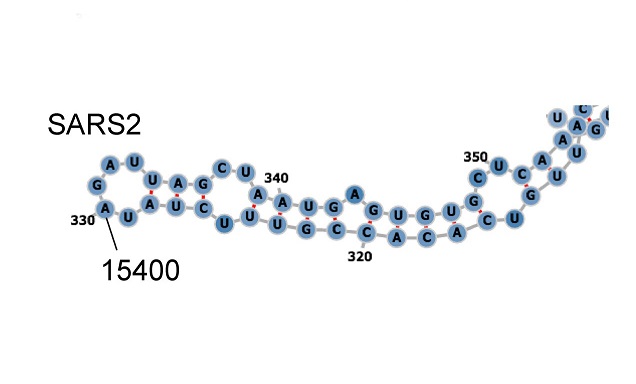BREAKING News! U.S. Researchers Discover 1.4-kb-Long Sequence in SARS-CoV-2 NSP12 And NSP13 Regions That Facilitates Viral RNA Packaging!
Thailand Medical - 1.4-kb-Long Sequence - SARS-CoV-2 - NSP12 And NSP13 - Viral RNA Packaging Jul 06, 2023 2 years, 5 months, 2 weeks, 1 day, 21 hours ago
Discovery could pave the way for better antivirals and prophylactics.
Thailand Medical: In a groundbreaking discovery, scientists at the Department of Microbiology and Immunology at The University of Texas Medical Branch in Galveston-USA have identified a crucial sequence in the genome of the severe acute respiratory syndrome coronavirus 2 (SARS-CoV-2) responsible for mediating the packaging of viral RNA into virus particles. This study finding sheds light on an essential step in the replication cycle of coronaviruses and could have significant implications for the development of antiviral drugs and targeted therapeutics.

The packaging of the viral RNA genome into virus particles is a vital process for the replication of coronaviruses. To investigate this mechanism, the study team employed a single-cycle, replicable mutant of SARS-CoV-2 and demonstrated the preferential packaging of the virus's genomic RNA into purified virus particles. Building upon previous studies on a related coronavirus, they designed a series of replication-competent SARS-CoV-2 minigenome RNAs to pinpoint the specific viral RNA region crucial for packaging.
Their study findings revealed that a 1.4-kb-long sequence derived from the nsp12 and nsp13 coding regions of the SARS-CoV-2 genomic RNA is essential for the efficient packaging of the virus's minigenome RNA into virus particles. Furthermore, they highlighted the significance of the entire 1.4-kb-long sequence for optimal packaging.
Corresponding and lead researcher, Dr Kaori Terasaki from the Department of Microbiology and Immunology, The University of Texas Medical Branch, Galveston told
Thailand Medical News, “This discovery underscores the differences in the packaging sequences between SARS-CoV-2 and other coronaviruses, such as the mouse hepatitis virus (MHV).”
He added, “The MHV packaging signal, located at the nsp15 coding region, is a 95-nt-long sequence responsible for packaging MHV genomic RNA. Contrasting with this, the newly identified packaging sequence in SARS-CoV-2 emphasizes the non-conservation of both the location and sequence/structural features of the RNA element(s) that drive the selective and efficient packaging of viral genomic RNA across different subgenera within the Betacoronavirus genus.”
Elucidating the mechanism of SARS-CoV-2 RNA packaging is of paramount importance for the development of antiviral drugs that can hinder this crucial step in the virus's replication cycle. However, due to the challenges of working with SARS-CoV-2 in biosafety level 3 (BSL3) facilities, the knowledge about the RNA packaging mechanism has been limited. The researchers overcame this hurdle by utilizing a single-cycle, replicable SARS-CoV-2 mutant that can be handled in a BSL2 lab, enabling them to demonstrate the preferential packaging of full-length SARS-CoV-2 genomic RNA into virus particles.
This breakthrough not only identified the specific 1.4-kb-long RNA region in SARS-CoV-2 that is vital for RNA packaging but also paved the way for a better understanding of the mechanisms behind SARS-CoV-2 RNA packaging.
The COVID-19 pandemic caused
by SARS-CoV-2 has had devastating global consequences, with millions of deaths and severe impacts on public health and the economy. The emergence of highly transmissible variants like the Omicron variant has posed additional challenges, particularly in vaccinated populations. While several vaccines have been effective in preventing severe COVID-19, there is currently only one FDA-approved antiviral drug for SARS-CoV-2 treatment.
The study's significance lies in the experimental evidence demonstrating the selective packaging of genomic RNA, but not subgenomic mRNAs, into virus particles of SARS-CoV-2.
In conclusion, the discovery of a 1.4-kb-long sequence in the SARS-CoV-2 genome that mediates viral RNA packaging represents a significant advancement in our understanding of the virus's replication cycle. This finding opens up new avenues for developing antiviral drugs and targeted therapeutics against SARS-CoV-2 and related coronaviruses. By unraveling the mechanisms behind RNA packaging, researchers are moving closer to effective strategies for combating COVID-19 and mitigating its impact on global health.
The study findings were published in the peer reviewed Journal of Virology.
https://journals.asm.org/doi/10.1128/jvi.00659-23
For the latest on SARS-CoV-2 Research, keep on logging to
Thailand Medical News.
